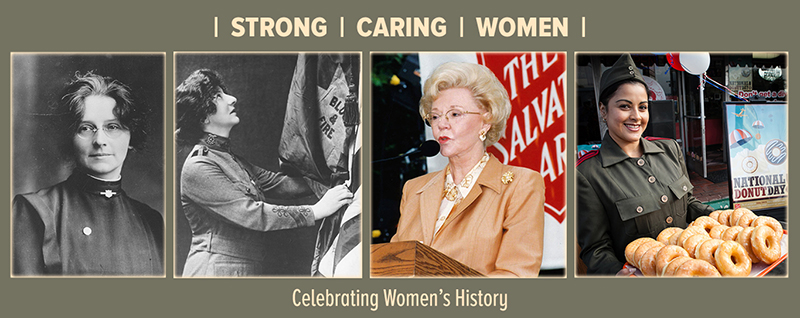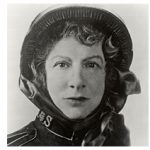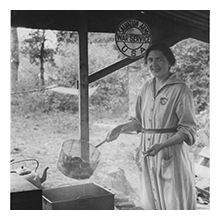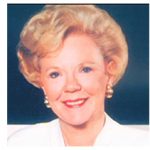A Rich History of Strong and Caring Women

Today, women are speaking up for themselves and others in a way they haven’t in decades. We’re seeing empowerment in the workplace, an increase in public service, and push-back against harassment and assault. We are rejoicing in a new collective voice showcasing strong, intelligent and passionate women.
Historically, many organizations have not encouraged leadership by women, but this was never the case with The Salvation Army. From the beginning, the Army has empowered women to advocate for and serve the most vulnerable in our world. As we celebrate Women's History Month and International Women's Day (March 8th), we'd like to highlight a few exemplary women who have made a difference, with the Army backing their charge.
Evangeline Booth
 Evangeline Booth was the seventh of eight children born to General William Booth and his wife, Catherine. She grew up in The Salvation Army, helping her parents spread the mission of caring for those whom society had forgotten – the poor, the drunk, and the destitute. She brought hope and love to those who had none. Booth was so strong that she was often sent wherever there was opposition to The Salvation Army or their work was threatened. Her father, General Booth, was often quoted as saying “Send Eva!”
Evangeline Booth was the seventh of eight children born to General William Booth and his wife, Catherine. She grew up in The Salvation Army, helping her parents spread the mission of caring for those whom society had forgotten – the poor, the drunk, and the destitute. She brought hope and love to those who had none. Booth was so strong that she was often sent wherever there was opposition to The Salvation Army or their work was threatened. Her father, General Booth, was often quoted as saying “Send Eva!”
During the aftermath of the 1906 San Francisco earthquake, Evangeline led a mass open-air meeting in New York’s Union Square, where she raised more than $12,000 to support relief workers. The Salvation Army's Disaster Relief Services remain integral to our work around the globe today, including supporting first-responders and victims after Hurricanes Harvey and Irma last year.
In 1917, Evangeline sent 250 Salvation Army volunteers to France’s front lines during World War I to provide comfort and aid to soldiers. The volunteers started frying pastry dough in soldiers' helmets and distributing doughnuts. Hence, the famous Doughnut Lassies were born.
Evangeline continued to lead the charge in Doing the Most Good, and in 1934, she was elected General by the High Council; becoming the first woman to lead the international organization. Under her leadership, The Salvation Army expanded its services, establishing hospitals for unwed mothers, soup kitchens, emergency shelters, and homes for aging adults.
The Doughnut Lassies
 In the midst of WWI, Evangeline Booth sent 250 Salvation Army volunteers overseas to support the US soldiers fighting in France. There, they set up small huts located near the front lines to give soldiers clothes, supplies and baked goods. The Doughnut Lassies began frying donuts in soldiers’ helmets. The tasty treats boosted morale and won the hearts of the soldiers. In addition to serving fresh-fried pastries, Doughnut Lassies provided spiritual aid and comfort. They were a link home to family and friends. Their work on the front lines was rekindled during World War II. Today, the Army honors the Doughnut Lassies efforts by celebrating Donut Days annually in June.
In the midst of WWI, Evangeline Booth sent 250 Salvation Army volunteers overseas to support the US soldiers fighting in France. There, they set up small huts located near the front lines to give soldiers clothes, supplies and baked goods. The Doughnut Lassies began frying donuts in soldiers’ helmets. The tasty treats boosted morale and won the hearts of the soldiers. In addition to serving fresh-fried pastries, Doughnut Lassies provided spiritual aid and comfort. They were a link home to family and friends. Their work on the front lines was rekindled during World War II. Today, the Army honors the Doughnut Lassies efforts by celebrating Donut Days annually in June.
Eliza Shirley
 Eliza Shirley pioneered the establishment of The Salvation Army in the United States. Born in England, she dedicated herself to The Salvation Army at 16 years of age. The following year, her father informed her they were moving to Philadelphia, Pennsylvania. So Eliza approached General William Booth for his endorsement and guidance to share the Army's message across the ocean. He warned Eliza that new faiths were often unwelcome and to prepare herself for a tough journey.
Eliza Shirley pioneered the establishment of The Salvation Army in the United States. Born in England, she dedicated herself to The Salvation Army at 16 years of age. The following year, her father informed her they were moving to Philadelphia, Pennsylvania. So Eliza approached General William Booth for his endorsement and guidance to share the Army's message across the ocean. He warned Eliza that new faiths were often unwelcome and to prepare herself for a tough journey.
Upon arrival in Philadelphia in 1879, Eliza and her family's efforts to start The Salvation Army in the US were mostly met with anger and disdain. Crowds often threw mud, stones, vegetables and more. Their first meeting was with only 12 people; and about a month afterward, the lot where they held their meeting was on fire. The flames drew a large crowd, and Eliza bravely embraced the opportunity to sing and preach.
Soon Eliza found a new meeting place and the work of The Salvation Army in the United States began. By the following year, she sent word to General Booth back in England requesting additional support. In response, General Booth dispatched Commissioner George Scott Railton with seven women officers. Within three years, the demand for The Salvation Army had grown so that the group were sent to open additional corps community centers. Eliza eventually moved to Chicago. Watch the short video below to learn about what the Chicago Cubs did for her during the World Series - in 1932!
Joan Kroc
 After a tour of San Diego, Joan Kroc, wife of McDonald’s founder Ray Kroc, said that she recognized a community that was in desperate need of a safe gathering place; a place with facilities and trained professionals to nurture children’s social skills, arts appreciation, and athletic potential. To help her vision become a reality, Joan entrusted The Salvation Army with $87 million to build the first Ray & Joan Kroc Corps Community Center.
After a tour of San Diego, Joan Kroc, wife of McDonald’s founder Ray Kroc, said that she recognized a community that was in desperate need of a safe gathering place; a place with facilities and trained professionals to nurture children’s social skills, arts appreciation, and athletic potential. To help her vision become a reality, Joan entrusted The Salvation Army with $87 million to build the first Ray & Joan Kroc Corps Community Center.
She was so pleased with the outcome that in 2003, she bequest $1.5 billion to The Salvation Army to build state-of-the-art community centers around the country. Always established in under-resourced areas, the Kroc Centers continue to provide access to arts and music, sports and recreation, health and fitness, education and more, including here in Chicago.
In 2014, a national study quantified the positive socioeconomic impact the Kroc Centers are creating in their previously under-served communities - totaling more than $258 million. According to the study, Kroc Center Chicago's one-time impact of construction-related spending and launch totaled more than $117 million and created 843 jobs. Now, Kroc Chicago contributes more than $14.5 million annually in local value, bringing economic and social vitality to the community.
Making History Today
Women continue to make their mark with The Salvation Army, ensuring that we help the helpless and restore hope to the hopeless. And they continue to make history.
